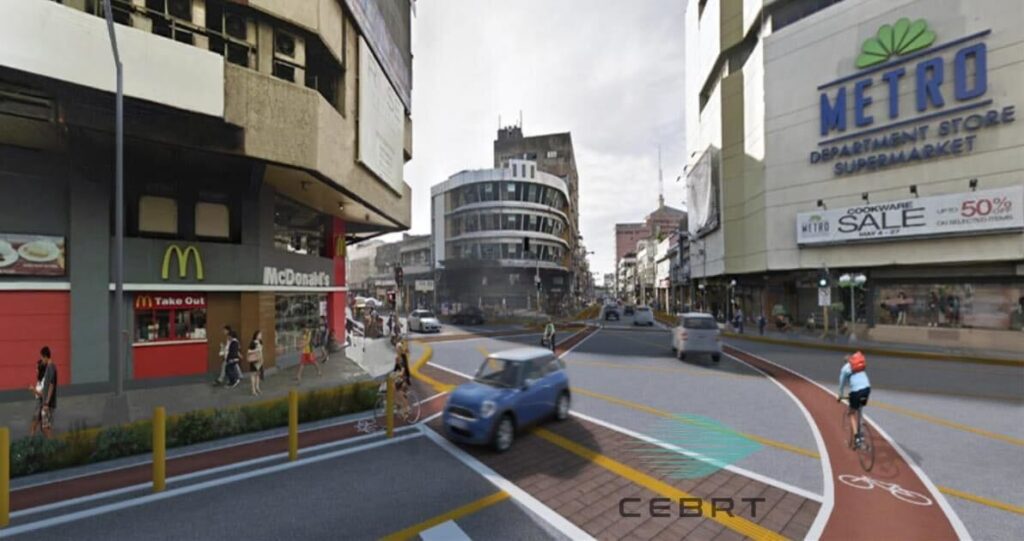
The ‘Link to the Port’ feature will start from the intersection of P. Del Rosario and a portion of Osmeña Boulevard, continuing to MJ Cuenco right in front of Plaza Independencia. | Photo credits: CBRT/Facebook
CEBU CITY, Philippines – The Cebu City Transportation Office (CCTO) said that no official application for permits for road closures or even the reinstallation of lamp posts had been received for the link to the port, despite ongoing discussions surrounding the project.
‘Link to the Port’ is the added component of the Cebu Bus Rapid Transit (CBRT) project. It will start from the intersection of P. Del Rosario and a portion of Osmeña Boulevard, continuing to MJ Cuenco right in front of Plaza Independencia.
The controversial six streetlights installed along Osmeña Boulevard, which were removed and then slated for reinstallation, are part of the link to the port project. However, the issue lies in the fact that no permit was issued for their initial installation.
READ MORE:
‘Misplaced’ street lights in downtown area part of Cebu BRT project
Cebu City streetlights removed, to be reinstalled later – exec
Official application for permits
In a recent media forum on July 2, Lawyer Kent Jongoy, assistant department head of the CCTO, said that CCTO had not yet received any official application for permits regarding the link to the port aspect of the BRT project.
Although he acknowledged the ongoing discussions within the Traffic Management Committee board, but he also emphasized the necessity of proper planning and coordination with relevant city departments, including the City Planning and Development Office (CPDO) and the Office of the Building Official (OBO), due to the project’s scope and implications.
“We are asking them for an endorsement from the city planning and development office and also makahatag sad sila siguro og katong permit na from the OBO para sad we can also give our recommendations to the city council because again like what I said earlier, it will permanently close a portion of Osmeña Boulevard,” he said.
(We are asking them for an endorsement from the city planning and development office and also that they can give the permit from OBO so that we can also give our recommendations to the city council because again like what I said earlier, it will permanently close a portion of Osmeña Boulevard.)
According to Jongoy, once the project starts, it will require a permanent closure of a portion of Osmeña Boulevard. However, he explained that a permanent street closure would require an ordinance, which would involve a lengthy process.
He expressed hope that the CBRT management would be aware of the complexities and necessity of adhering to this ordinance.
He added, “I hope it will become what it is advertised for to be the solution dili traffic situation but to the growing demands for effective and efficient public transportation in the city of Cebu and its neighboring cities.”
The CBRT management in collaboration with city officials, aims to align the initiative with ongoing urban development plans the pedestrianization projects spearheaded by Mayor Michael Rama and Vice Mayor Raymond Alvin Garcia. The initiative seeks to transform key thoroughfares into pedestrian-friendly zones while addressing public transit demands.
READ MORE:
4 business owners in Cebu City slam CBRT ‘Link to Port’ project
Invest in PH infra, investors urged
‘Not ready for pedestrianization’
Meanwhile, Jongoy expressed concerns about the area’s readiness for partial closure for pedestrianization, given the current transportation services.
“The area especially with the current transportation services that we have is not ready for it to be closed partially for the pedestrianization,” he said.
He pointed out the idea of traffic calming, which hasn’t started in that area yet. With 60 to 70 percent of jeepney routes passing through, along with numerous businesses and schools, narrowing the street could cause accessibility issues.
“Calming of traffic is a gradual introduction of measures that will, for this instance introduction of rerouting schemes one at a time. So if naa tay ibutang lang nato (there is something that we put there) approximately about 12 or 15 routes traversing in that area,” Jongoy explained.
He also mentioned the hope that narrowing the street would be accompanied by opening adjacent parallel streets. He acknowledged that this task would be significant for the CCTO, as they would need to reroute all public utility jeepneys.
“So the 12-15 routes comprise about 60 to 80 jeepney units. Hinay-hinayon nato sila’g transfer to their new diversion routes in parallel roads para sad ang acceptance sa mga tao will not be very different. Kay ngano man? It is just one block away… Nga dili man gyud ka molakaw (og layo) going to that new diversion route,” he said.
(So the 12-15 routes comprise about 60 to 80 jeepney units. We will slowly transfer them to their new diversion routes in parallel roads so that the acceptance of the people will not be very different. Why is this so? It is just one block away…That you need not walk far going to that new diversion route.)
The now-acting Mayor Garcia’s initial plan is to restrict private vehicles in Osmeña Boulevard — from Sanciangko intersection to MJ Cuenco. However, this raises questions about where students will alight and disembark from jeepneys during school days.
He also noted the ample sidewalks in the area, which could be extended to address this issue. The main challenge will be ensuring mobility and walkability in the area.
“But ongoing atong study, we are now looking forward into diversion routes that will separate north originating PUVs nga jeep gikan sa Lahug, Kalunasan, Apas, lahi na sila’g agianan,” he said.
(But our study is ongoing, we are now looking forward into diversion routes that will separate the north originating PUVs, that jeepneys from Lahug, Kalunasan, Apas, they would have different routes.)

